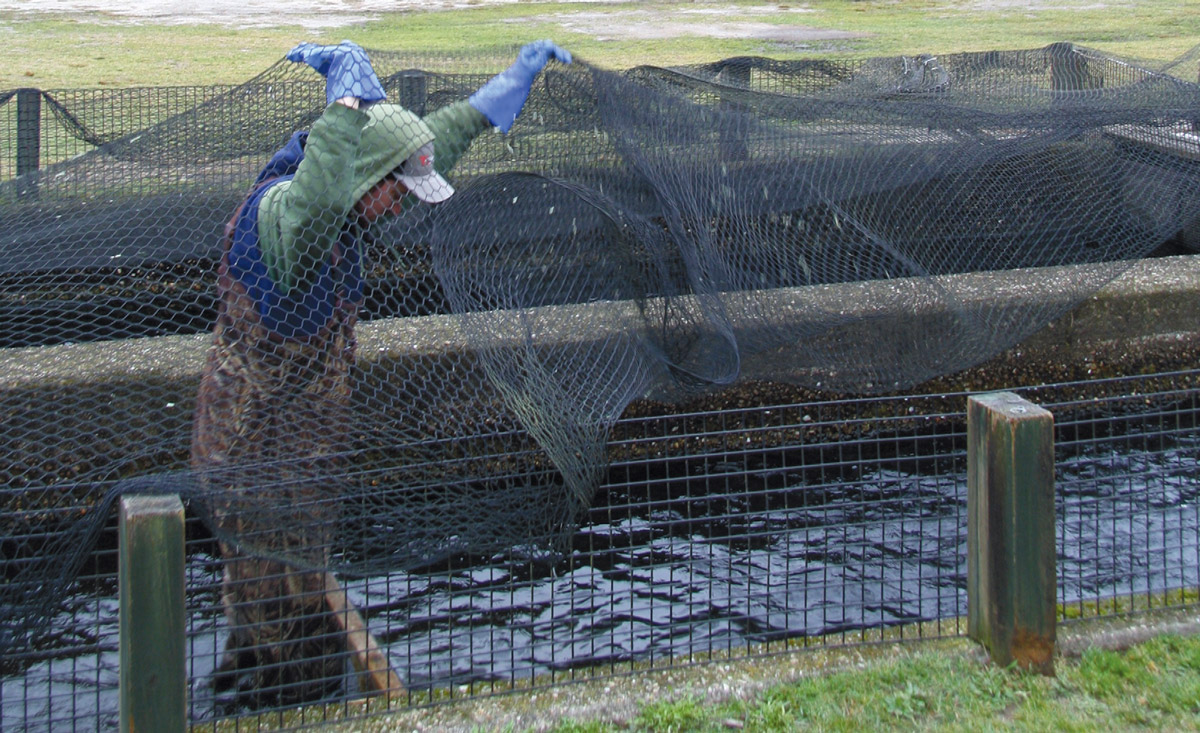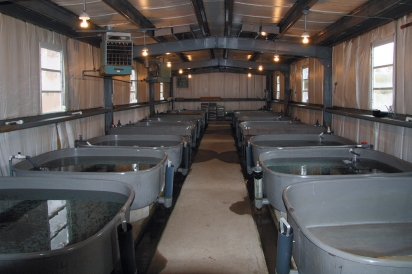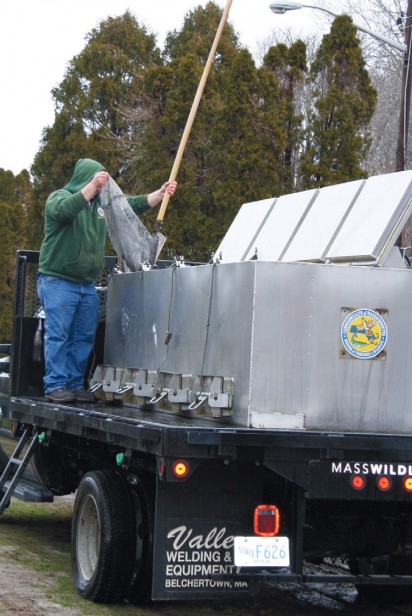It’s a Trout Time!
Marking the passage of time with a calendar, while efficient, can be a bit lackluster. Where’s the excitement? Where’s the thrill? Do you flip the page to March and say, “Ooh, it’s National Peanut Butter Day!” Or maybe, “Finally, ‘Mad For Plaid’ month is here again!” Probably not, but observing Father Time’s constant journey is made far more enjoyable by the periodic arrival of various sights and sounds. The return of the Hess Truck signifies that the holidays are upon us (according to those ubiquitous TV commercials). The familiar tinkling of an ice cream truck’s chimes drifting on a warm summer breeze confirms that the season finally has arrived. In between, to usher in the coming of spring, there isn’t a sight nearer or dearer to a fresh water angler’s heart than the vision of the fish stocking truck rolling to a nearby body of water.
The Massachusetts Division of Fisheries and Wildlife (MassWildlife) was founded in 1866 as a fisheries commission to combat the loss of Atlantic salmon stock due to pollution and the construction of dams. As environmental studies developed and the knowledge of the ecosystems around us increased, so did the charge of MassWildlife. It’s now tasked with the care of all facets of the environment within the state’s borders. Perhaps the most enjoyed aspect of MassWildlife’s duties is the yearly (and in some cases semiyearly) restocking of trout to many of the state’s ponds, lakes and rivers. The supply of brown, brook, tiger and rainbow trout come from five fish hatcheries located across Massachusetts. Four are centrally located in the towns of Belchertown, Montague, Palmer and Sunderland. The fifth hatchery, marked by a weather-worn and lichen-covered wooden sign, can be easily missed by locals and visitors alike as they drive along Route 6A in Sandwich.
Cedar trees form a perfect canopy for the drive onto the property. To the right, the tops of two of the 52 cement raceways that house the trout peek just above ground level. Forty-eight of them are for production while four are used as display pools that are divided by the species of trout. Visitors can see up close the differences between the brown and the brook trout, notice the colorful streaks that give the rainbow trout its name, and observe the grotesque under-bite of the tiger trout that could give any member of the Royal Hapsburg family a run for their money.
“I have people tell me all the time, ‘I’ve lived here 20 something years and never knew you were here!’” says Adam Davies, the hatchery’s manager. Davies graduated from the University of Massachusetts with a degree in wildlife and fisheries biology and promptly went to work for MassWildlife. “I was one of the lucky ones to get a job right out of school,” he states. After working seven years at the Belchertown hatchery, he and his wife moved out to Weymouth when Davies took a position in Sandwich. The two have since relocated to Plymouth. “The hour-long commute was killing me!” he laughs.
The Sandwich fish hatchery is actually one of the oldest continuously run hatcheries in the country, dating back to the 1800s. Back then, it was known as the Sandwich Trout Company, and the number of natural springs that provide perfect 50-degree, clean water from the aquifer below made for an ideal location for the business. The state took over the private company in 1912, and has been producing trout for area bodies of water ever since. Why trout? As Davies says, “They’re huge with the fishermen. They put up a good fight, and they taste good, too.” The reason the hatchery only breeds trout is that the other fish stocks are at satisfactory levels. “Everything else is doing fine on their own,” Davies confirms.
As evidence to their popularity, the trout stocking report page on the state’s website, Mass.gov, gets more hits than any other page. Gone are the days when anglers had to wait until Friday to find out what bodies of water were stocked that week. Now people can log on and see what stops the stocking truck made the previous day. It just won’t tell you precisely where the fish were stocked. “It’d be chaos if we did,” Davies points out. “Everybody would show up to that exact spot.”
Davies and his staff of three—Greg McSharry (assistant manager), Connor McMorrow and Cameron Young—work year round to produce all four species of trout (50,000 pounds in total) for the annual restocking that begins the first week in March and continues until Memorial Day. “After that, the water gets too warm,” Davies says. “When it does, it could kill them instantly.” When temperatures cool in the fall, a second smaller restocking of only rainbow trout takes place.
Like all farmers with livestock, it is a 365-day-a-year operation. “You know when we have a big storm and the governor says all nonessential state employees stay home? Yeah, we’re essential,” Davies says, letting out a single huff as only a man who spent four days and three nights here during one of the major blizzards of two years ago could do. The major concern is a loss of power to the pumps that supply the continuous flow of water from the four wells and to the aerators that oxygenate the water. Sure, there’s a generator on stand-by, but any generator owner can tell you that they’re not foolproof. So, everybody on the staff takes a two-week shift of being on call for just such emergencies. To date, there’s never been a catastrophic fish loss.
The trout are spawned in the fall in the hatch house. The fertilized eggs are placed in a trough with a continuous flow of water running over them. It’s all hands on deck during this critical stage. Not all eggs survive, and when one dies it can develop a fungus called Saprolegnia that can quickly affect nearby healthy eggs. To prevent its spread, the staff of four will spend six to eight hours a day monitoring the troughs for dead eggs and removing them before contamination can take hold.
The fish stay in the hatchery room through the fry stage. Being a “small fry” is a perfectly natural thing for a fish. It wasn’t until Davey Crockett used the term did it become an expression of condescension. Once they reach the fingerling phase (about 2-3 inches long), they’re moved outside and into the raceways where they will stay until the big moving day. The Sandwich hatchery is the only one in the state that raises all four species of trout because the tiger trout can be difficult to grow. It takes 200,000 eggs to develop 3000 tigers to maturity.
To relocate the trout, the Sandwich hatchery uses two trucks. Each one is equipped with aerators that keep the fish comfortable on their way to their far more spacious new homes. One truck can hold 700- 1000 pounds of fish; the fish average a pound each, and the smaller truck can carry 300 pounds. The smaller one is used for those hard-to-reach ponds where access can be a bit of a challenge. Two days prior to the move, the fish are cut off from food. When fish eat, they require more oxygen to help with digestion. The other reason is to prevent waste from contaminating such a confined space. The end result is great news for those looking to land a few trout—they go into the water hungry!
Once a raceway is cleaned out of fish, it’s time for the raceway to be cleaned. The removable dams that separate schools of fish are taken out and the entire length is drained. The dams trap waste and sediment along the way so the water is just as clean when it returns to the aquifer as it was when it was pumped out of it. The concrete, wire mesh and netting get power-washed, then left to bake in the sun for a few days. The Sandwich Hatchery is a class A facility, which means it is disease free.
The purpose of MassWildlife’s Fish hatcheries is to simply provide recreation for sports fisherman. The organization practices what is called “put and take”. As Davies explains, “We put them out there for everyone to take.” Davies does emphasize the “everyone” in that sentence. MassWildlife only stocks waters that are open to everyone. They do not dispense to private lands or businesses and do not sell their supply. It is a resource that is paid for by the anglers themselves. The fish hatcheries’ budget comes entirely from two sources: the hunting and fishing licenses that residents obtain each year, and a federal tax that is placed on the gear that they purchase. So if you’re a hunter or fisher, there your tax dollars are, hard at work.
Everyone can see the operation up close by stopping by for a visit. The Sandwich hatchery is open daily for self-guided tours, and be sure to arm yourself with quarters when you go. There’s a coin-operated food dispenser on site to allow visitors to feed the fish. In the summer, the hatchery can get pretty crowded with tourists looking for something different to do with the kids.
“On cloudy, non-beach days it gets pretty busy,” Davies claims. “Also after three straight days of rain, the parents are dying to get the kids out of the house!” In the cooler months, you could have the place almost to yourself. Besides the workers, there’s also a lengthy list of predators that are never far away. “If it eats fish, it’s in here,” Davies laughs. Seagulls, ducks, three types of herons (great blue, green and night), otters and minks all come by to try and catch a meal. In the summer, osprey will swoop in as well. That’s why the raceways have wire mesh sides and have netting draped over the tops. So, come for the fish, and stay for the fowl.
The Sandwich Fish Hatchery is a hidden gem in the truest form of the word. Gemstones aren’t vital for survival, but they make surviving a lot more livable. Sure, there’ll always be other fish in the sea (we hope). Yet, for the angler in the dappled sunshine at the water’s edge of a nearby pond, fighting that one-pound trout is pure joy. Whether it be for the escapism, the nourishment, or the thrill of the hunt, trout fishing is enjoyed by thousands of people across the state. Because of the ongoing hard work of a select few at the state’s fish hatcheries, it continues to be enjoyed each season. Fish rearing by the people, for the people…now that’s government that we can all get behind.
Sandwich Fish Hatchery
164 Route 6A, Sandwich
Open daily 9am-3pm
508-888-0008








